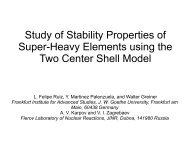The strange formula of Dr. Koide
The strange formula of Dr. Koide
The strange formula of Dr. Koide
Create successful ePaper yourself
Turn your PDF publications into a flip-book with our unique Google optimized e-Paper software.
Quark masses and gims<br />
m<br />
[GeV/c 2 ]<br />
ג<br />
[GeV 1/2 /c]<br />
u 0.5 0.71<br />
d 6 2.5<br />
s 105 10<br />
c 1250 35<br />
b 4500 67<br />
t 174000 417<br />
total 180000 532<br />
Table 1: Average <strong>of</strong> the quark masses given by the Particle Data Book [17],<br />
and their corresponding gims, i.e., ג ≡ √ m.<br />
mass <strong>of</strong> the t from the data [17], i.e., 174 GeV/c 2 , the precision <strong>of</strong> the generalized<br />
<strong>Koide</strong> <strong>formula</strong>, Eq. (3) in which the sums <strong>of</strong> the gims and <strong>of</strong> their<br />
squares are taken over all six quarks, is about 9%.<br />
Finally, a third and possibly the most interesting way is to repeat the<br />
previous calculation by taking all six quark masses from the data [17]. More<br />
precisely, due to the theoretical uncertainties <strong>of</strong> extracting the quark masses<br />
from the data, these six masses are taken as the averages between the extreme<br />
values cited in Ref. [17], as listed in Table 1. Thus, as 532 2 /180000 = 1.572<br />
instead <strong>of</strong> 1.5, <strong>Koide</strong>’s <strong>formula</strong> applies to a six-quark complex vector with a<br />
precision <strong>of</strong> about 5%, which is quite good. 3<br />
We can therefore conclude this section by stressing that <strong>Koide</strong>’s <strong>formula</strong><br />
applies reasonable well to quark masses, either if these masses are calculated<br />
with Barut’s <strong>formula</strong> generalized to quarks, or if the masses are taken from<br />
the Particle Data Book. Agreement is particularly good if we take for the<br />
masses <strong>of</strong> the three lighter quarks those given by Barut’s <strong>formula</strong>, or if we<br />
take all six quark masses from the data. This suggests that while Barut’s<br />
<strong>formula</strong> seems to contain an important element <strong>of</strong> truth concerning the light<br />
parton masses (where the factors 3/2 and α ≈ 1/137 appear to play some<br />
fundamental role [18]), <strong>Koide</strong>’s <strong>formula</strong> seems to embody a similar element<br />
<strong>of</strong> truth concerning the heavy partons (including the mass <strong>of</strong> the top quark<br />
which does not fit the Nambu-Barut <strong>formula</strong>). However, as is well known,<br />
3 <strong>The</strong> ratio 283/180 being quite precisely equal to π/2 illustrates how easily one can get<br />
a good agreement with a beautiful number. (Jean-Pierre Hurni, private communication.)<br />
5



